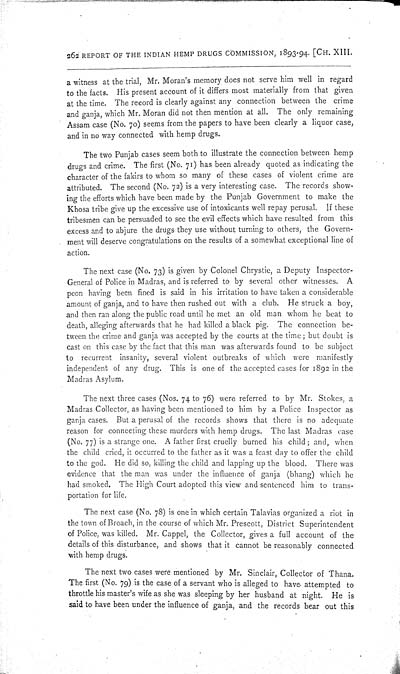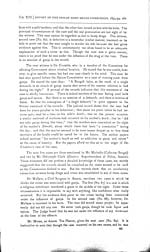Medicine - Drugs > Report of the Indian Hemp Drugs Commission, 1894-1895 > Volume I
(295) Page 262
Download files
Individual page:
Thumbnail gallery: Grid view | List view

262 REPORT OF THE INDIAN HEMP DRUGS COMMISSION, 1893-94. [CH. XIII.
a witness at the trial,
Mr. Moran's memory does not serve him well in regard
to the facts. His present account of it differs most materially
from that given
at the time. The record is clearly against any connection between
the crime
and ganja, which Mr. Moran did not then mention at all. The only
remaining
Assam case (No. 70) seems from the papers to have been clearly a
liquor case,
and in no way connected with hemp drugs.
The two Punjab cases seem
both to illustrate the connection between hemp
drugs and crime. The first (No. 71) has been already quoted as
indicating the
character of the fakirs to whom so many of these cases of violent
crime are
attributed. The second (No. 72) is a very interesting case. The
records show-
ing the efforts which have been made by the Punjab Government to
make the
Khosa tribe give up the excessive use of intoxicants well repay
perusal. If these
tribesmen can be persuaded to see the evil effects which have
resulted from this
excess and to abjure the drugs they use without turning to others,
the Govern-
ment will deserve congratulations on the results of a somewhat
exceptional line of
action.
The next case (No. 73) is
given by Colonel Chrystie, a Deputy Inspector-
General of Police in Madras, and is referred to by several other
witnesses. A
peon having been fined is said in his irritation to have taken a
considerable
amount of ganja, and to have then rushed out with a club. He struck
a boy,
and then ran along the public road until he met an old man whom he
beat to
death, alleging afterwards that he had killed a black pig. The
connection be-
tween the crime and ganja was accepted by the courts at the time;
but doubt is
cast on this case by the fact that this man was afterwards found to
be subject
to recurrent insanity, several violent outbreaks of which were
manifestly
independent of any drug. This is one of the accepted cases for 1892
in the
Madras Asylum.
The next three cases
(Nos. 74 to 76) were referred to by Mr. Stokes, a
Madras Collector, as having been mentioned to him by a Police
Inspector as
ganja cases. But a perusal of the records shows that there is no
adequate
reason for connecting these murders with hemp drugs. The last
Madras case
(No. 77) is a strange one. A father first cruelly burned his child;
and, when
the child cried, it occurred to the father as it was a feast day to
offer the child
to the god. He did so, killing the child and lapping up the blood.
There was
evidence that the man was under the influence of ganja (bhang)
which he
had smoked. The High Court adopted this view and sentenced him to
trans-
portation for life.
The next case (No. 78) is
one in which certain Talavias organized a riot in
the town of Broach, in the course of which Mr. Prescott, District
Superintendent
of Police, was killed. Mr. Cappel, the Collector, gives a full
account of the
details of this disturbance, and shows that it cannot be reasonably
connected
with hemp drugs.
The next two cases were
mentioned by Mr. Sinclair, Collector of Thana.
The first (No. 79) is the case of a servant who is alleged to have
attempted to
throttle his master's wife as she was sleeping by her husband at
night. He is
said to have been under the influence of ganja, and the records
bear out this
Set display mode to: Large image | Zoom image | Transcription
Images and transcriptions on this page, including medium image downloads, may be used under the Creative Commons Attribution 4.0 International Licence unless otherwise stated. ![]()
| India Papers > Medicine - Drugs > Report of the Indian Hemp Drugs Commission, 1894-1895 > Volume I > (295) Page 262 |
|---|
| Permanent URL | https://digital.nls.uk/74574656 |
|---|---|
| Description | Chapter XIII, cont. |
| Description | [Volume 1]: Report. |
|---|---|
| Attribution and copyright: |
|




![Plate [16]](https://deriv.nls.uk/dcn4/7443/74435009.4.jpg)